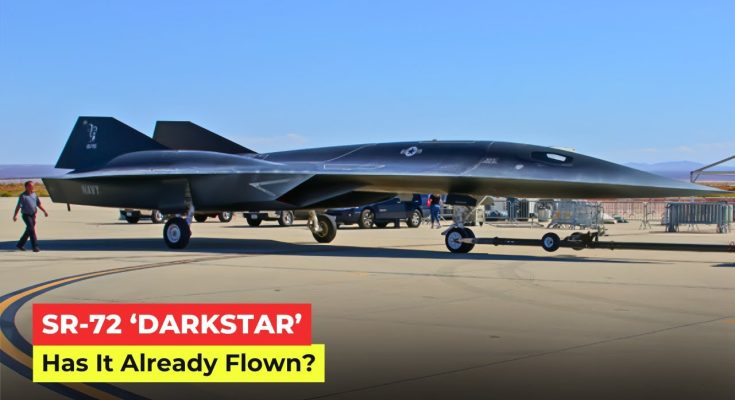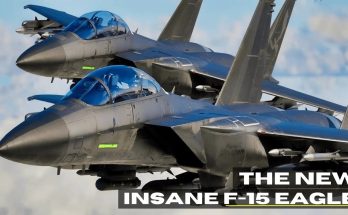The SR-72 Darkstar is the highly anticipated successor to the legendary SR-71 Blackbird, and it’s been officially declared real by the U.S. Air Force, sparking excitement and curiosity across the aviation and defense communities. After years of rumors, leaks, and speculation, the SR-72 Darkstar has emerged as a revolutionary aircraft designed to push the limits of speed, stealth, and reconnaissance capabilities. Here’s what you need to know about this next-gen hypersonic aircraft and its potential impact on modern warfare.
1. A Stealthy Hypersonic Beast
The SR-72 Darkstar is designed to be hypersonic, capable of flying at speeds greater than Mach 5 (five times the speed of sound, or over 3,800 miles per hour). This incredible speed puts it in a class of its own, making it one of the fastest aircraft ever built.
-
Mach 6+ Capabilities: The SR-72 is rumored to reach speeds of up to Mach 6 (around 4,600 mph), far outpacing any current jet in operation, including the SR-71 Blackbird, which holds the record for the fastest manned aircraft at Mach 3.3.
-
Speed Advantage: The extreme speed of the SR-72 gives it the ability to cover vast distances quickly, making it an incredibly valuable asset for high-speed reconnaissance missions or strike operations.
2. The SR-71 Blackbird Legacy
The SR-72 Darkstar is often seen as the successor to the SR-71 Blackbird, which retired from service in the late 1990s after a remarkable career that spanned decades. The Blackbird was famous for its speed, altitude, and stealth features, making it nearly untouchable by enemy aircraft and missiles. The SR-72 aims to build on these capabilities, with a focus on even faster speeds, improved stealth, and next-gen reconnaissance technology.
-
Advanced Sensors: The SR-72 will likely be equipped with cutting-edge sensors for real-time intelligence gathering, including advanced radar systems and electronic surveillance capabilities, surpassing anything the Blackbird could have imagined.
-
Speed and Stealth Balance: While the Blackbird was a marvel of speed and stealth in its time, the SR-72 aims to take this to the next level by incorporating next-gen stealth technology that makes it nearly invisible to both radar and infrared sensors, even at hypersonic speeds.
3. Advanced Propulsion System
One of the most exciting aspects of the SR-72 Darkstar is its propulsion system. Hypersonic flight requires cutting-edge engines capable of reaching and maintaining such high speeds, and the SR-72 is believed to use an innovative combination of engines to achieve this.
-
Ramjet and Scramjet Technology: The SR-72 likely utilizes a combination of ramjet and scramjet engines, which are designed for efficient operation at hypersonic speeds. These engines function by compressing incoming air at high velocities before mixing it with fuel and igniting it to propel the aircraft forward.
-
Exotic Fuel and Propulsion Design: Given the extreme speeds, the SR-72 will also require highly specialized fuels and advanced engine designs to withstand the heat and pressure generated during hypersonic flight.
This advanced propulsion system is key to enabling the SR-72 to achieve its hypersonic performance, opening the door to new strategic capabilities in air combat and intelligence gathering.
4. Surveillance and Reconnaissance Capabilities
Much like its predecessor, the SR-72 Darkstar is expected to play a critical role in reconnaissance and surveillance missions, providing the U.S. military with real-time intelligence from high above the battlefield. The Darkstar will likely be equipped with an array of advanced sensors, including:
-
High-Resolution Imaging Systems: Capable of capturing detailed imagery of targets from extreme altitudes and speeds, enabling intelligence gathering over vast areas in a short amount of time.
-
Signals Intelligence (SIGINT): The SR-72 is likely equipped with electronic intelligence capabilities, enabling it to intercept and analyze enemy communications and radar emissions, making it a powerful tool for electronic warfare and tactical surveillance.
-
Stealthy Reconnaissance: Thanks to its stealth design, the SR-72 can perform these missions without being detected by adversaries, remaining virtually invisible to enemy radar, infrared, and other detection systems.
The ability to perform high-speed, high-altitude reconnaissance without being intercepted will give the U.S. a significant strategic advantage over adversaries.
5. Potential Military Uses
The SR-72 Darkstar is not just about speed; it’s about providing a revolutionary new capability for the U.S. military in a variety of domains. The Darkstar’s high speed and stealth features would make it a powerful asset in strategic reconnaissance, strike missions, and electronic warfare. Some of its potential uses include:
-
Penetrating Denied Airspace: The SR-72 could be used to penetrate heavily defended airspace at hypersonic speeds, bypassing surface-to-air missile (SAM) systems and enemy interceptors, making it an invaluable tool for intelligence collection or strike missions.
-
Rapid Response Strike Missions: With its ability to travel at hypersonic speeds, the SR-72 could be used for quick reaction strike missions, delivering precision-guided munitions to time-sensitive targets in enemy territory.
-
Anti-Satellite Operations: Given its speed and altitude, the SR-72 could potentially be used in anti-satellite operations, where it could engage enemy satellites or perform surveillance on hostile space assets.
-
Deep Strike Missions: The SR-72’s ability to cover vast distances rapidly could make it useful for deep strike operations, where precision strikes are needed against high-value targets deep within enemy territory.
6. Stealth and Survivability
The SR-72 will incorporate next-gen stealth technology that is designed to make it nearly invisible to enemy radar and infrared sensors, even at its incredible speeds. Some of the stealth features include:
-
Shape and Coatings: The SR-72 will likely use a combination of advanced coatings and a low-observable airframe shape to reduce its radar signature, ensuring that it can operate in highly contested airspace without being detected.
-
Heat Signature Management: At hypersonic speeds, the heat generated by the aircraft’s engines is immense, making it visible to infrared sensors. The SR-72 will likely employ innovative heat-dissipation technologies to minimize its infrared signature, making it even harder to detect.
-
Electronic Countermeasures: In addition to its physical stealth, the SR-72 may be equipped with advanced electronic countermeasures (ECM) to disrupt enemy radar and communications, further enhancing its survivability in hostile environments.
7. The SR-72 Darkstar in the Real World
While much of the information about the SR-72 remains classified or speculative, its official reveal by the U.S. Air Force marks a significant milestone in the development of hypersonic technologies. The Darkstar is likely part of a broader strategy to develop a new generation of air combat platforms capable of operating in the most dangerous and contested environments.
-
Testing and Development: As of now, the SR-72 is still in the testing and development phase. Given the complexity of hypersonic flight, it will likely take several more years before the aircraft is fully operational.
-
A New Era of Aviation: The SR-72 represents the dawn of a new era in aviation, where hypersonic and stealth technologies will dominate the skies, potentially changing the balance of power in modern warfare.
Conclusion
The SR-72 Darkstar represents the next generation of military aviation, combining hypersonic speeds, advanced stealth, and cutting-edge reconnaissance capabilities. While details remain scarce, the announcement that the aircraft is real is a monumental step forward for the U.S. Air Force and the future of modern combat aviation. As the SR-72 continues its development and testing, it could redefine how intelligence, surveillance, and strike operations are conducted in the 21st century. This incredible aircraft will undoubtedly play a central role in strategic operations for years to come, providing the U.S. military with an unmatched advantage over adversaries in the future.



